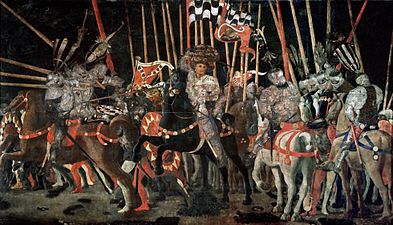Paolo Uccello
Paolo di Dono , better known as Paolo Uccello , (* 1397 in Florence , † December 10, 1475 in Florence) was an Italian painter and mosaic artist.
Uccello is considered the father of perspective painting in Italy and was a keen to experiment and also a little eccentric contemporary. In works such as The Battle of San Romano (around 1440), his use of perspective and the vanishing point creates new ways of spatial representation.
life and work
In 1407 he joined Lorenzo Ghiberti's workshop as an assistant, where he learned to sculpt; he left Ghiberti in 1415 to join the rich guild of doctors and pharmacists ( Arte dei Medici e Speziali ) (artists were not allowed to form their own guild in Florence at that time) and to turn to painting. From 1427 on, Uccello worked in Venice for two years, creating mosaics for the Church of San Marco, and returned to Florence in 1431. In 1436 he created the fresco of Sir John Hawkwood in the cathedral there , with which he invented the type of equestrian statue that was later to be taken up many times. Because of the many birds and other animals in his paintings, his contemporaries gave him the name "Uccello" - bird. His house was full of painted birds, cats, dogs and all sorts of strange animals that he could get pictures of, similar to The Hunt (around 1460), where he tried to make the dogs look three-dimensional, knowing full well that the spatial view is decisive for the impression on the viewer.
He found his patrons in the powerful Florentine banker family of the Medici . Around 1440 he made three battle pictures for the Bartolini Salimbeni family of an insignificant victory of the Florentines over the Sienese in 1432 ( The Battle of San Romano, around 1440 ); these impress with their abundance of figures in a clear perspective image structure. The pictures adorned Lorenzo de 'Medici's bedroom and are now in the National Gallery in London, in the Uffizi in Florence and in the Louvre in Paris.
The Battle of San Romano , National Gallery , London
The Battle of San Romano , Uffizi Gallery , Florence
The Battle of San Romano , Louvre , Paris
1467-69 he stayed at the court of Urbino, where he painted the predella The Desecration of the Host of 1467/8, also known as Pala del Corpus Domini , today in the Galleria Nationale delle Marche , Urbino for the Corpus Domini Brotherhood . These scenes from the legend of the saints, made as six base pictures , were intended to underline the main work of the Flemish painter Justus van Ghent on the main altar, the communion of the apostles of 1473/74.
Paolo Uccello is known for his scientific studies. When difficult, apparently insoluble problems of perspective preoccupied him, he would lock himself up in his house for weeks or months and not come out. One of his friends was the mathematician Manetti, with whom he liked to discuss Euclid . Donatello , who was also a friend of his, claimed that Uccello was wasting his time drawing mazzocchi - the peculiarly shaped headgear of men in the Quattrocento - and projecting points and spheres with 72 facets, all seen in perspective and from different angles. “Crazy Paolo”, as his contemporaries called him, was obsessed with the geometry hidden in the forms. According to Vasari, "... lonely, eccentric, melancholy and poor, he was always drawn to the most difficult things in art." For him, reality was in the geometric shape, not in the color. To express this, to Vasari's horror, he painted “the fields blue, the cities red, the buildings in various shades corresponding to his imagination.” Stylistically, he was still close to the Middle Ages, he preferred decorative and schematic effects rather than humanistic ones Aimed for "purity of the line".
In old age, Uccello was so strange that he no longer received any orders, became completely helpless and finally had to ask the state for tax relief.
Nonetheless, Paolo Uccello is one of the most versatile painters of the Florentine early Renaissance after Masaccio and from today's perspective is regarded as the immediate predecessor of the most important Italian masters.
literature
- Paolo d'Ancona: Paolo Uccello . Publisher Anton Schroll, Vienna / Munich 1960.
- Wilhelm Boeck : Paolo Uccello. The Florentine Master and his Work . Grote, Berlin 1939.
Web links
- Literature by and about Paolo Uccello in the catalog of the German National Library
- Works by Paolo Uccello at Zeno.org .
- Biography with further links at Encyclopædia Britannica Online (English)
- Selection of works. Archived from the original on April 12, 2013 ; accessed on March 6, 2018 . in the Graphic Collection of the Louvre, Paris (French)
Individual evidence
- ^ Painted equestrian statue of Giovanni Acuto (John Hawkwood) . 1436
- ↑ James H. Beck: Painting of the Italian Renaissance , Könemann Verlag, Cologne, 1999, pp. 84–91.
- ↑ James H. Beck: Painting of the Italian Renaissance . Könemann Verlag, Cologne 1999, ISBN 3-8290-0485-0 , p. 88-89 .
- ^ Norbert Schneider: History painting. From the late Middle Ages to the 19th century. Cologne u. a. 2010. p. 86.
- ↑ Paul Johnson: The Renaissance . Berlin 2002
| personal data | |
|---|---|
| SURNAME | Uccello, Paolo |
| ALTERNATIVE NAMES | Paolo di Dono |
| BRIEF DESCRIPTION | Italian painter and mosaic artist |
| DATE OF BIRTH | 1397 |
| PLACE OF BIRTH | Florence |
| DATE OF DEATH | December 10, 1475 |
| Place of death | Florence |







